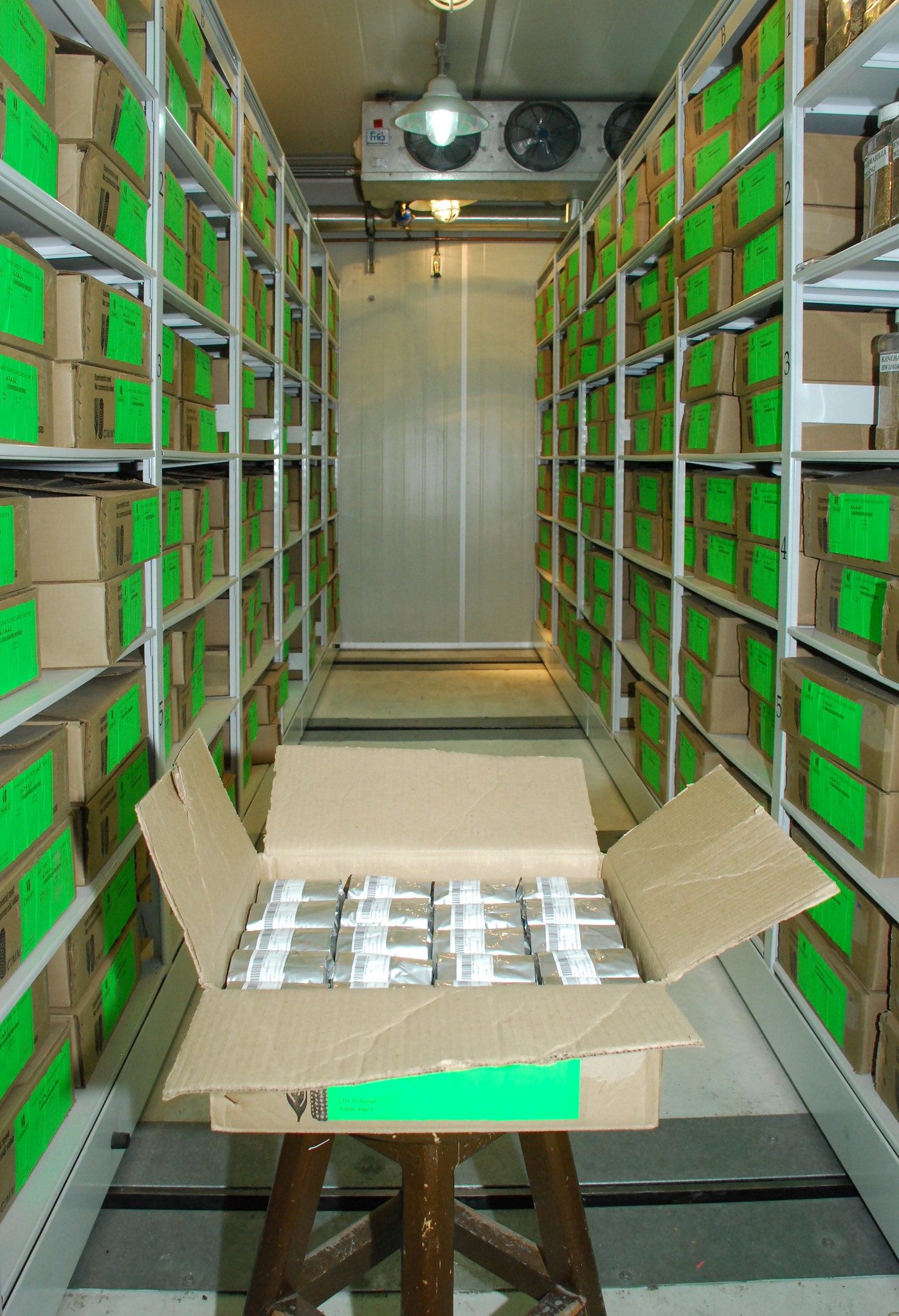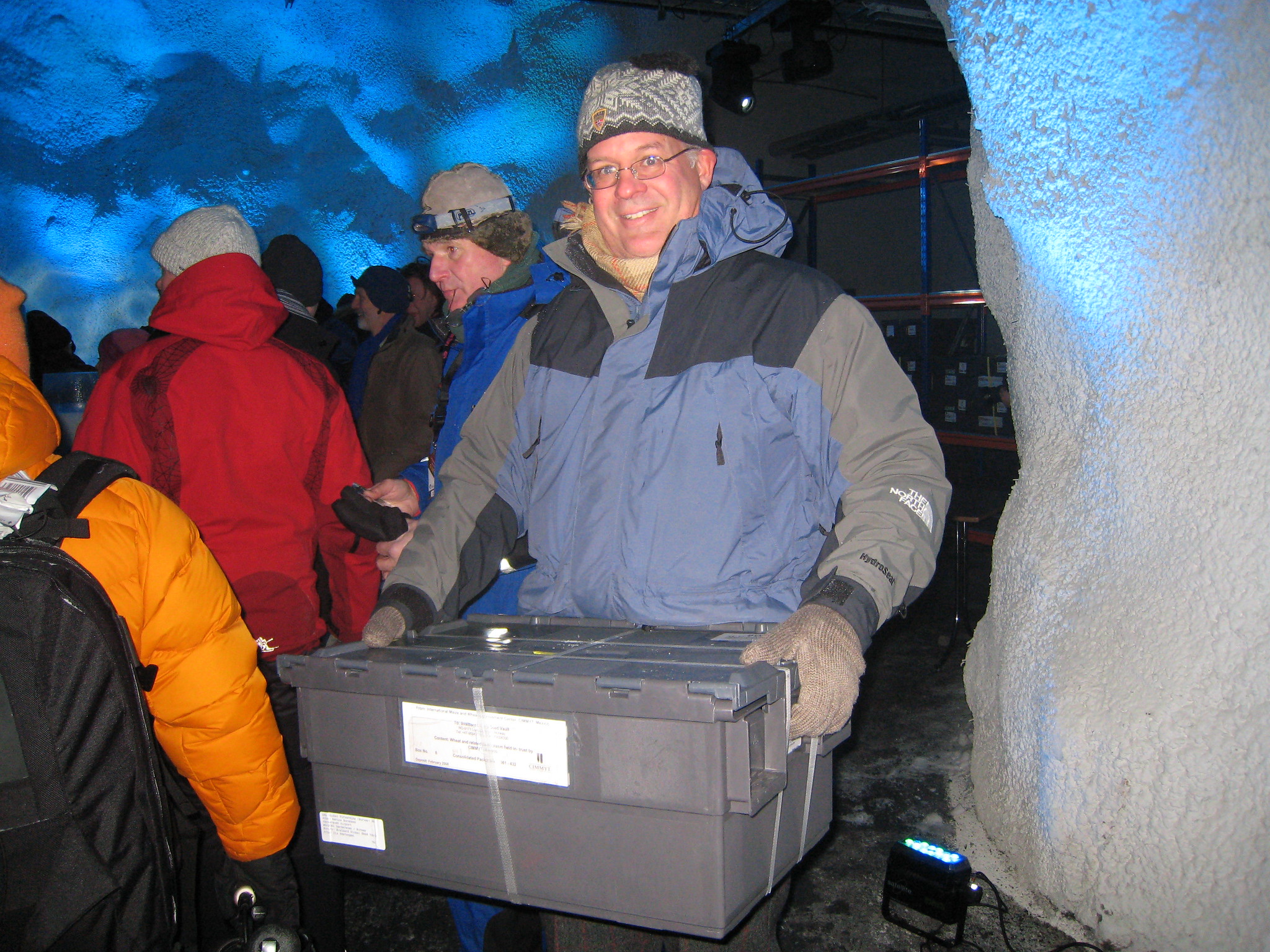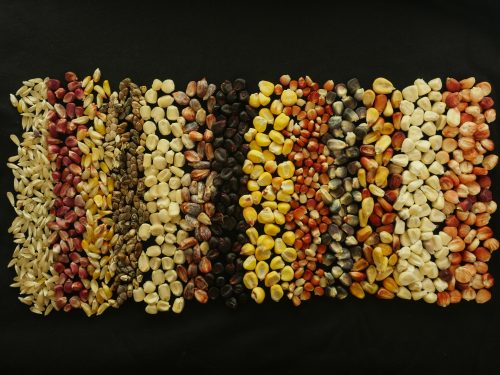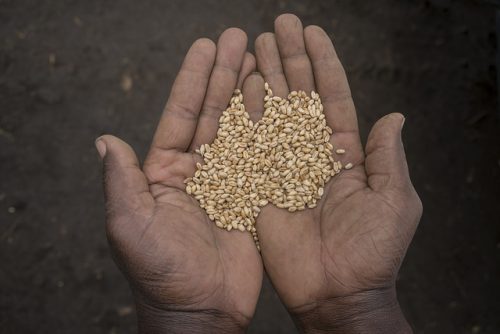Our food system isn’t ready for the climate crisis
“We’ll never get back all the diversity we had before, but the diversity we need is out there,” says Matthew Reynolds, head of wheat physiology at CIMMYT.
“We’ll never get back all the diversity we had before, but the diversity we need is out there,” says Matthew Reynolds, head of wheat physiology at CIMMYT.
As climate breakdown and worldwide conflict continue to place the food system at risk, seed banks from the Arctic to Lebanon try to safeguard biodiversity.
Germplasm banks around the world are protectors of genetic diversity, altogether preserving roughly 700,000 samples of wheat varieties from fields far and wide. Thomas (Tom) Payne, the head of CIMMYTs Wheat Germplasm Collection, or genebank, manages the Mexico-based collection of nearly 150,000 accessions from over 100 countries. He has been affiliated with CIMMYT since 1988, and has dedicated his career to wheat improvement and conservation, working in Ethiopia, Mexico, Syria, Turkey and Zimbabwe. In addition to managing the genebank, he is the chair of the CGIAR Genebank Managers Group, has served as secretary to the CIMMYT Board of Trustees, manages the CIMMYT International Wheat Improvement Network and was awarded the Frank N. Meyer Medal for Plant Genetic Resources in 2019.
In advance of his retirement in July 2021, CIMMYT senior scientist Carolina Saint Pierre sat down with Tom Payne over Zoom to ask him a few questions from the wheat breeding team about his lifetime of experience in wheat biodiversity conservation.
What is your favorite Triticum species?
Triticum aestivum, bread wheat, is my favorite. Bread wheat feeds around 2.7 billion people worldwide. In fact, more food products are made from wheat than from any other cereal. An interesting detail about Triticum aestivum, however, is that it’s a hexaploid, meaning that it is a distinct species formed from three separate species. The inherent genetic diversity resulting from its three ancestral species and its ability to naturally incorporate genetic diversity from other species gives breeders a broad palette of genetic diversity to work with for current and future needs.
How can genebank managers of vital food crops add diversity to existing collections?

There are many vital genebanks, with community, national, regional, and international affiliations. Harmonization of these efforts into a global conservation network is needed. In wheat, for example, we do not adequately understand the diversity of the crop’s wild relatives. A recent study from Kansas State University observed that two thirds of the accessions of Aegilops tauschii held by several key collections were duplicates. This is an alarm to the global wheat community. The ex-situ collection of a critical species is less representative and more vulnerable than the sheer number of accessions would imply. We need to conduct a thorough characterization of all crop wild relatives to assess the risks to diversity, and a gap analysis of newly collected materials to ensure that their long-term conservation adds unique diversity to existing collections.
Which of the Triticum species that you store in the CIMMYT wheat genebank should, in your opinion, be explored much more?
Species that can readily cross with cultivated wheat, both bread wheat and durum wheat, should have intensified conservation and characterization efforts. Examples of these include Triticum monococcum subspecies monococcum (Einkorn) and Triticum turgidum subspecies dicoccon (Emmer).
What were the most surprising results from the genetic diversity analyses of nearly 80,000 wheat accessions from the CIMMYT genebank?
Modern, molecular genetic tools confirmed, for the most part, the centuries-old Linnaean taxonomic classification of Triticum and Aegilops species. There are generally two broad schools of taxonomists, “lumpers” and “splitters.” The former groups species based on a few common characteristics, and the latter defines multiple taxa based on many traits. The Seeds of Discovery work, in partnership with Michiel van Slageren from Kew Gardens, is confirming the salient taxonomy of the Triticum genus. Van Slageren previously studied and published a taxonomic monograph on the wheat ancestral Aegilops genus.
How can a genebank managers help in pre-breeding?
Maintaining native genetic diversity for use in the future is an important role that genebank managers play in pre-breeding and applied breeding processes. Furthermore, the identification of rare and odd variation plays an important role in understanding trait expression. Genebank managers are now gaining a stronger understanding of the genetic representativeness of their collections, and they can identify where gaps in the conserved genetic diversity may exist. A better understanding of the collections will enable their sustainable conservation and use.

What would you consider the biggest challenge when striving for genetic diversity in breeding wheat for the future?
CIMMYT and other CGIAR Centers are rightfully proud of their stewardship of global public goods, and the free access to and distribution of germplasm and information. Yet outside of the CGIAR, the two-way sharing of germplasm and knowledge is often still not realized by many crop communities. International agreements have attempted to bridge recognition of intellectual property rights with guaranteed access and benefit-sharing mechanisms. However, the playing field remains uneven between public and private organizations due to varied levels of investment and exclusivity, access to technology and information, and marketability.
What is one way we can ensure long-term conservation of staple crops around the world?
In the past few years, several internationally renowned germplasm collections have been destroyed due to civil conflicts, natural disasters and fires — for example in Aleppo, Cape Town and Sao Paulo. Each time, we hear what a shame it was that the destroyed heritage was lost, that it was irreplaceable and beyond value. When a genebank loses an accession, the ancestral lineage extending hundreds of generations becomes permanently extinct. Genebank managers recognize this threat, and hence duplicate samples of all accessions are now slowly being sent to the Global Seed Vault in Svalbard for long-term preservation.
Cover photo: Tom Payne, Wheat Germplasm Collections & International Wheat Improvement Network Manager. (Photo: X. Fonseca/CIMMYT)
Seed security is the first step towards food security. The International Maize and Wheat Improvement Center (CIMMYT) preserves 28,000 unique seed samples of maize and 150,000 of wheat at its genebank in Mexico.
The Global Seed Vault in Svalbard opened in 2008. Since then, CIMMYT has duplicated and deposited 50 million seeds — 170,000 samples of maize and wheat — at Svalbard.
This year, CIMMYT sent 24 boxes of seed, with 332 samples of maize and 15,231 samples of wheat.
Join these seeds on a journey, as they travel more than 8,000 km from CIMMYT’s genebank in Mexico to the Global Seed Vault in the Arctic.
A supermarket, rather than a museum
This treasure, kept in the global network of genebanks, is key to ensuring sustainable, nutritious agricultural systems for future generations.
The purpose of genebanks is not just to preserve seed, but to use its biodiversity to address the needs of the future — and the needs of today.
Climate change is already impacting resource-poor farmers and consumers in low- and middle-income countries. Researchers and breeders at CIMMYT are rolling out solutions to these challenges, based on the diverse genetic resources kept in the genebank. As a result, farmers can use new varieties that yield more, need less inputs, and are more tolerant to drought or heat.
Our internal estimates show that about 30% of maize and more than 50% of wheat grown worldwide can be traced to CIMMYT germplasm.
Humanity’s legacy
Maize and wheat originated about 10,000 years ago. Since then, it’s survived war, drought, diseases, migration, birds, low yields — and the hard choice between feeding children or planting again.
Keepers of genebanks around the world are only the depositors of this legacy, which belongs to all humanity. CIMMYT will continue to preserve these seeds and to make their biodiversity available to researchers and famers, to solve today’s and tomorrow’s most pressing issues.
Cover photo: A NordGen staff member brings a box of seed into the Global Seed Vault in Svalbard, Norway. (Photo: Thomas Sonne/Common Ground Media for NordGen)

EL BATAN, Mexico (CIMMYT) — The “Doomsday Vault,” that safeguards fall-back collections of key food crop seeds in the arctic cold of Longyearbyen, Norway, marks its tenth anniversary this year. To celebrate, leaders in the conservation of crop genetic resources are gathering next week to discuss best practices and to encourage sustainable use of the resources.
The Svalbard Global Seed Vault sits 1,300 kilometers north of the Arctic Circle; the farthest north commercial flights will take you. It is described as the world’s largest secure seed storage and was established by the Norwegian Government in February 2008. Repurposing an abandoned coal mine, the global seed vault is set deep into the natural permafrost of the Norwegian island of Svalbard.
Over the last decade, seed-preserving institutions worldwide have shipped backup collections of seed and other plant parts for storage in the vault, which now holds nearly 900,000 varieties of essential crops, representing over 4,000 plant species, which could be drawn upon to restart agriculture in case of a catastrophe.
The International Maize and Wheat Improvement Center (CIMMYT) is the top contributor to the vault, with over 150,000 unique collections containing a total of nearly 50 million seeds and representing roughly 85 percent of the entire CIMMYT germplasm bank collection.
The target is to have 90 percent of the CIMMYT entire collection backed up at Svalbard within two years, according to Thomas Payne, head of CIMMYT’s Wheat Germplasm Bank, which is located in Mexico. CIMMYT’s Maize Germplasm Bank, led by Denise Costich, has already reached that goal.
“We send seeds every other year, accumulating packets until we have a critical mass and sending them in a large, single shipment,” Payne said.
Preparing and shipping the seed involves intricate coordination and painstaking work. For starters, seed must be sent in the winter to avoid it sitting on hot airport tarmacs. Additionally, the Svalbard vault opens for new deposits only a few times a year, so shipping logistics need to match up those dates.

Only seed of the highest quality is sent to Svalbard, in part to ensure that the stored seed retains as long as possible its ability to germinate.
CIMMYT Germplasm Bank seed collections are regularly tested for germination capacity by placing a batch of seeds in a wet paper towel for 7-10 days. When less than 85 percent of a unique collection is viable, then the entire collection is replaced with fresh seed grown from the viable portion.
“There are seed collections at CIMMYT that still meet the minimum viability standard after more than 50 years under storage,” Payne said, noting that the center’s long-term collections are kept at minus 18 degrees Centigrade and in low humidity.
Payne said the center keeps duplicate collections in Mexico of all the seed it sends to Svalbard and monitors those Mexico back-ups to keep tabs on the viability of its Svalbard deposits.
Payne explained “To check seed viability, we have to take seeds out of storage, representing a loss of several hundred seeds. It’s almost a self-defeating process, balancing viability testing with sufficient quantities of seed to test and distribute.”
Payne said scientists are seeking new, non-invasive ways to test seed viability, potentially by checking seed respiration rates or rapid germination imaging technologies.
The government of Norway and the Global Crop Diversity Trust cover the cost of storage and upkeep of the Svalbard Global Seed Vault, coordinating shipments in conjunction with the Nordic Genetic Resource Center. Established in 2006, the Crop Trust supports the conservation and availability of crop diversity for food security worldwide and helps to fund CIMMYT’s work to collect and conserve maize and wheat genetic resources. The CGIAR Genebank Platform also supports CIMMYT’s maize and wheat germplasm bank.

Learn more about the activities of the Maize Germplasm Bank here, and about the Wheat Germplasm Bank here.
The Maize and Wheat Germplasm banks at the International Maize and Wheat Improvement Center are funded by Global Crop Diversity Trust, the CGIAR Genebank Platform and Germany’s development agency.

MEXICO CITY, Mexico (CIMMYT) — Staff of the gene bank of the International Maize and Wheat Improvement Center (CIMMYT) have sent 56 boxes of nearly 28,000 samples of maize and wheat seed from the center’s collections, to be stored in the Svalbard Global Seed Vault.
Located on Spitsbergen Island in Norway’s remote Arctic Svalbard Archipelago, 1,300 kilometers south of the North Pole, the vault provides free, “safe deposit” cold storage for back-up samples of seed of humanity’s crucial food crops.
“CIMMYT has already sent 130,291 duplicate samples of our maize and wheat seed collections to Svalbard,” said Bibiana Espinosa, research associate in wheat genetic resources. “This brings the total to nearly 158,218 seed samples, which we store at Svalbard to guard against the catastrophic loss of maize and wheat seed and diversity, in case of disasters and conflicts.”
Thursday’s shipment contained 1,964 samples of maize seed and 25,963 samples of wheat and weighed nearly a ton, according to Espinosa.
The wheat seed came from 62 countries and nearly half the samples comprised “landraces” — locally-adapted varieties created through thousands of years of selection by farmers.
“Of the maize samples, 133 contained seed of improved varieties, 51 were of teosinte — maize’s direct ancestor — and 1,780 were of landraces,” said Marcial Rivas, research assistant for maize genetic resources. “Many landraces are in danger of permanent loss, as farmers who grew them have left the countryside to seek work and changing climates have altered the landraces’ native habitats.”
The government of Norway and the Crop Trust cover the cost of storage and upkeep of the Svalbard Global Seed Vault, coordinating shipments in conjunction with the Nordic Genetic Resource Center. Established in 2006, the Crop Trust supports the conservation and availability of crop diversity for food security worldwide and helps to fund CIMMYT’s work to collect and conserve maize and wheat genetic resources. CIMMYT’s maize and wheat germplasm bank is supported by the CGIAR Research Program on Genebanks.